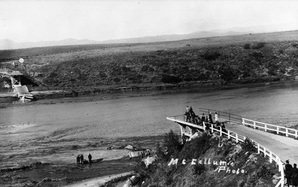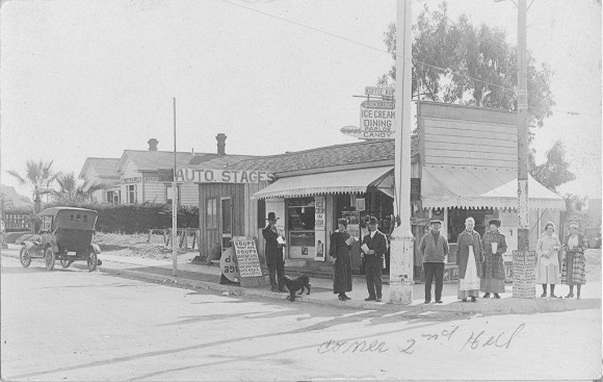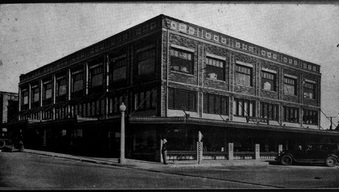|
By Kristi Hawthorne Oceanside embarked on its next 25 years with determination and enthusiasm. Building is always a sign of progress for any town and the next two decades would not disappoint. Will Scott opened Oceanside’s first theater, the Elysium on Second Street in 1913. His popular barbershop shared the same building. The first film to be shown was the “Battle of Gettysburg” while the Oceanside Band performed. The newspaper reported that the Elysium was “indicative of the new spirit that has taken hold here, and which is certain to lead to greater and better things in the way of material and artistic development.”  In the summer of 1913, work began on the state highway between Oceanside and Encinitas. Grading and improvements were made with sixty mules and a work crew. By December a crew of seventy-five mules and sixty-five men were at work to complete the road from Oceanside to Las Flores. Teams hauled cement, sand and crushed rock from the railroad yard in Oceanside, laying 600 feet of roadbed a day. Improvements were also made on the bridges so that road was “passable for horse travel or for automobile.” Oceanside's Hill Street became part of the 101 Highway from Oregon to the Mexican border. A bond issue was passed in 1913 and provided funds to build a separate high school building. The cornerstone was laid on May 3, 1913 and the building was completed by September. Fifty-five students and a staff of four began the school year in the new high school which contained four classrooms, a study hall and office. In 1920 a science building was added to the campus at a cost of $17,500. In 1914 the Laskey Feature Film Company stopped in town with film director Cecil B. De Mille. De Mille, a registered guest at the Oceanside Beach Hotel, was here to film David Belasco's drama, "The Rose of the Rancho" featuring scenes from Pala, Oceanside and Mexico. It would be one of the first of many movies to be filmed in Oceanside and the San Luis Rey Valley. Locals played extras and Oceanside beaches and hotels were used as a getaway for movie stars. While camping on the beach was a popular pastime since Oceanside was established, in 1914 Tent City was organized by a group of businessmen. Beach goers and visitors could rent tents which were 12x16 with 6 foot walls, laid with wooden floors. The tents could accommodate two to six persons and were equipped with couches, stoves, chairs, cutlery and cooking utensils. Advertisements for Tent City were sent throughout the southland to cities such as Riverside, San Bernardino, Redlands, Elsinore, Santa Ana. Each year Tent City grew in popularity and accommodations increased. The Automobile Club of Southern California announced in October of 1915 that “motorists may look forward to a completely paved road between Los Angeles and San Diego by the middle or latter part of November.” That same year Merrill Brothers opened an auto garage and became one of the first car “dealerships” in the city, selling Fords. In 1916 a devastating storm flooded San Diego County. Over 10 inches of rain fell during the month of January, and the relentless deluge overflowed a swollen San Luis Rey river, filled with debris and wiped out bridges. Pine trees from as far as Palomar Mountain were brought down in the raging flood waters and deposited on the beach. Railroad tracks were displaced and roads were destroyed. Twenty-two people were killed, including three residents of the San Luis Rey Valley: Mrs. C. M. Hermens, Mary Hermens, and Mrs. Carl Nelson. The Oceanside Blade reported a harrowing story: “Three women lost their lives in an attempt to escape from the Hermens Ranch when the house was seen to be imperiled by the sudden rise of the river Thursday evening. When it became evident that the waters were going to reach the buildings David Jones, whose ranch adjoins on the North, joined Mr. Hermens with a team and taking the women and the two children of the Hermens family and the small child of the Nelson’s attempted to reach the Jones house. After going a short distance the team became mired and it was necessary to abandon it. The two men took the three children and started in the darkness for safety while the women waited in the wagon. When Mr. Hermens returned he managed to cut loose the horses but at that instant the wagon upset and threw all its occupants into the water and they disappeared. Hermens was struck by driftwood but managed to get to a rope which David Jones had fastened to the windmill and was dragged to the house almost dead. When the bodies were discovered Mrs. Nelson was found pinned down by the wagon. Mrs. Hermen’s body was about thirty feet away with most of the clothing removed and it is thought that she had taken it off with the idea that her chance of escape would be better. The body of Miss Hermens was found down near the San Luis Rey bridge.” Countywide bridges and roads were impassible and small towns were isolated The Oceanside pier was used to bring in supplies to the surrounding communities until the railroad and auto bridges over the San Luis Rey river could be rebuilt. In 1917 the Signal Film Company used the San Luis Rey River Bridge for the scene of a "thrilling wreck". In a serial called "The Lost Express," the film company ran a Studebaker off the north approach to the old cement bridge which had been washed away in the 1916 flood. The following year the Blanche Sweet Film Company shot scenes of a war film, "The Unpardonable Sin" which included staging an automobile wreck in South Oceanside and chasing after "German spies" on the highway. The Highway Commission agreed to pay for two-thirds of the cost of paving Hill Street (renamed Coast Highway in 1996) 1917. Voters approved a bond election in November of that year and construction began in 1918 and completed in July of that year. Hill Street became part of the 101 Highway and for years was the main route from Los Angeles to San Diego and brought countless travelers through Oceanside. In 1918 an influenza epidemic killed several hundred people in San Diego County and thousands world-wide. In Oceanside Dr. Robert S. Reid attended to the sick and dying. He issued warnings and banned people from congregating to stop the spread of the epidemic: “The influenza situation is such that in my opinion, it will not improve until a compulsory mask ordinance is adopted with penalty. This should require everyone appearing in public, working in stores, etc., to wear a gauze mask all the time while he is in public.” In 1919 Prohibition was enacted and the highway through Oceanside became even more popular as motorists traveled to Mexico to drink. The Oceanside Police Department was kept busy arresting drunk drivers and apprehending bootleggers. Police Chief Charlie Goss and his officers made many arrests, confiscating and eliminating the forbidden drink which was transported on the 101 Highway to and from Los Angeles. Bootleggers also used boats to transport alcohol which was often smuggled from Mexico. When Prohibition finally ended, Officer Harold Davis rode "shotgun" on the truck that delivered the first bottle of beer to Oceanside and saved the bottle for posterity. Movie companies continued to film in Oceanside and in July of 1922 the Cosmopolitan Picture Company registered at Oceanside's Beach Hotel and began filming of Peter B. Kyne's story, "The Pride of Palomar." Scenes from Santa Margarita ranch, San Luis Rey Mission, Guajome Rancho, and Oceanside were used. Universal Pictures filmed scenes for a Western, "The Loving Brand", on the Santa Margarita ranch in 1923, featuring a roundup and "real buckaroo work". The Tiffany Company of the Bud Borsky Productions of Hollywood filmed a 1927 production on the ship "George Billings", with members of the cast staying in Oceanside. Hollywood's most famous silent movie stars and notable couple, Douglas Fairbanks and Mary Pickford, were frequent guests to Oceanside. In June of 1923 Fairbanks and Pickford established a beach camp used by other film notables. Fairbanks reported that it was his "sixth season here and that Oceanside has undoubtedly the finest beach in California." The June 21, 1923 Blade reported: "Among the guests of the tent colony of Douglas Fairbanks and Mary Pickford on the beach during the past week has been Cornelius Vanderbilt, Jr. of New York." The 1920’s saw new construction and development in Oceanside. Martin’s Meat Market built a new store in 1923 on the west corner of Second (Mission) and Tremont. The Palomar Theater was built in 1924 on the 300 block of North Hill (Coast Highway) by A.J. Clark. Next door was Sweetwood's Sweet Shop operated by Mr. and Mrs. Harold Sweetwood, a popular spot for Oceanside teenagers. Jesse Newton constructed the "Newton Building" on Second Street in 1925 and was the home of Furman's Variety Store and the Oceanside Funeral Parlor. In 1927 he built a two story building at 208 North Hill (Coast Highway) which became the new home for the Squirrel Inn. Many new homes were being constructed during the mid-1920's, particularly in a new subdivision built by B.C. Beers called Plumosa Heights, named for the plumosa palms lining the streets. This exclusive neighborhood includes West and Shafer Streets, two of the street names are named for his children, Alberta and Leonard. Plumosa Heights continues to be a desirable neighborhood with concrete streets, original light posts and unique, beautiful homes. The Oceanside Rotary Club was formed in 1924. Meetings were held on Fridays at the Oceanic Cafe. Early members included Dick Merrill, Al Whisler, Charles Berry, J.E. Harris, W.S. Spencer and J.B. Welch, Jack Taylor and C.T. McKeehan. The old Bank of Oceanside, a Victorian brick structure on the northwest corner of Second and Hill (Mission and Coast Highway) was torn down in 1925. Built in 1887 it was considered too old-fashioned by many and it was replaced by a more "modern" squared brick building. This became the home of the First National Bank of Oceanside and later housed the Ben Franklin Five and Dime and Kings Men’s Wear. In 1926, Julius E. Keisker purchased property on Hill Street at Topeka for a new hotel. Plans for a two-story stucco building, twenty-six room hotel at a cost of $140,000 was built by O.M. Wallace. The Keisker Hotel opened formally in June, 1927 and was a popular spot for autoists traveling through Oceanside on the 101 Highway. The Bank of Italy was built on the northeast corner of Hill Street (Coast Highway) at Second Street (Mission Avenue) in 1928. Nelson & Willett, local builders, started construction in October of 1927. The name was changed to Bank of America during the war years. In the mid 1960's the building was the home of A&W Root Beer Stand and has since been the location of Johnson's Sporting Goods for over twenty years. On July 1, 1929, the J.C. Penney Company leased the first floor of the I.O.O.F. lodge building and Store No. 1259 was opened in August of 1929. Forrest “Frank” A. Jones was the first store manager. Harry Weinberg was the assistant manager and Ina Winters was hired as the cashier. Having a national department store in Oceanside further elevated its business district and the J.C. Penney store remained at that location until it closed on April 4, 1970 and relocated to the shopping mall in Carlsbad. The Oceanside Fire Station No. 1 was built in 1929 on the corner of Nevada and Third (Pier View Way), designed by architect Irving Gill. It has since been named the Walt Johnson Fire Station in memory of Fire Chief Walter Johnson. Johnson, a boisterous but likeable character, was "well-known for his large size booming voice, colorful conversation, flashy cars, dark shirts, broad-brimmed hat, cigar and frank manner." By 1930 there were 18 volunteer firemen, as only the Chief, Assistant Chief and captain were paid a salary. This historic fire station is still in operation today and continues to serve downtown. Brothers Paul and Harold Beck arrived in Oceanside in 1929 from Iowa. The Beck family purchased the local newspaper and merged it with a weekly publication, the Oceanside News, creating the Oceanside Daily Blade Tribune. They became the youngest newspaper publishers in the State of California. Paul Beck was just 24 years old, Harold 26. The original Blade newspaper office was too small to accommodate a growing newspaper and in 1936 the Becks hired architect Irving Gill to design a new building at Tremont and First Street (now Seagaze). This would be Gill's last project, as he died the same year. Charles Borden began construction for a large, three-story brick building at the corner of Third (Pier View Way) and Tremont in 1929. The basement was used for storage and work rooms, the main floor held men's clothing and shoes. Furniture and home furnishings were located on the second floor. Unfortunately, due to the Depression, Borden was unable to keep the store open and was said to have lost his "entire life's savings". The building served many uses over the years and was torn down in the early 1980s. It was in 1933 that Oceanside truly felt the impact of the Depression. The First National Bank closed and many people in the city were impacted and devastated by the loss. Lionel Van Deerlin remembered in an interview just before his death in 2008: “The bank in which my father worked, the First National Bank, closed its doors, ‘failed’ that is, two weeks before Franklin Roosevelt took office. As you are obviously too young to remember, but some would, the day after Roosevelt took office, the first thing he did was close every bank in the country. He didn’t want any more failures coming in and leaving people penniless. He found a way to save the banks, but it wasn’t in time to save the Oceanside bank. So for my family, the Depression was a very real thing for two or three years. My father being in his 50’s, some 15 million in the country out of work, older men were not the first to be hired.” A group of twelve homes was built by 1934 in an exclusive enclave in South Oceanside at the end of Pacific Street. Pasadena resident Kenyon A. Keith purchased 28 acres of oceanfront property and contained homes resembling a French fishing village that was known as St. Malo. Well-to-do property owners used St. Malo for vacation and summer homes. Early film director Jason S. Joy's home was identified as "La Garde Joyeuse" and included an outdoor bowling alley and volley ball court. Author Ben Hecht was another resident, as well as Frank Butler, who co-wrote "Going My Way". The beautiful community of St. Malo remains one of Oceanside's best kept secret and continues to serve as summer homes and getaways for the rich and famous. In January of 1934 plans began for a new city hall building. Councilman Charles W. Hoegerman had prepared preliminary plans and sketches for an addition to the civic center, which comprised the fire and police station. Architect Irving Gill changed and revised these original sketches to conform to earthquake standards. The city hall and library was built without a bond issue and built by day labor for a cost of around $9,000. It was much needed work for many during the Depression years. The new civic center located at 704 Third Street (Pier View Way) was dedicated December 19, 1934. It is now the home of the Oceanside Museum of Art. In January of 1936 Oceanside dedicated a new post office building, located on First Street (Seagaze). Construction began in 1935 and was financed by the W.P.A. This was the first permanent post office in Oceanside and “marked a milestone in the progress of the community.” The hand-carved coat of arms above the door was sculpted by Stuart Holmes and the beautiful mural inside the lobby was painted by renowned artist Elise Seeds. Oceanside’s first major construction project since the Depression was the Margo Theater, built in 1936 at 217 North Hill (Coast Highway). The theater was to be originally named for the Rancho Santa Margarita but the name was too long for the marquee so it was simply shortened to Margo. In the 1950's the name of the theater was changed to the Towne Theater and is now the home of Sunshine Brooks Theater. As Oceanside recovered from the Depression years, new construction in 1937 was nearly three times as great as the previous year and building permits for December of that year promised that 1938 would begin with a building boom. Little did anyone know of the change the war years would soon bring to Oceanside. By Kristi Hawthorne, President of the Oceanside Historical Society
paul thomas williams
11/26/2017 07:58:19 am
a lot of research and work was obviously done here. thank you so very much. paul
Dominic Camacho
8/29/2018 03:19:32 pm
When was San Luis Rey Elementary School Built and opened on 3535 Hacienda Drive, Oceanside, CA 92054 Comments are closed.
|
Categories
All
Archives
December 2023
|
|
|
|
|



 RSS Feed
RSS Feed
